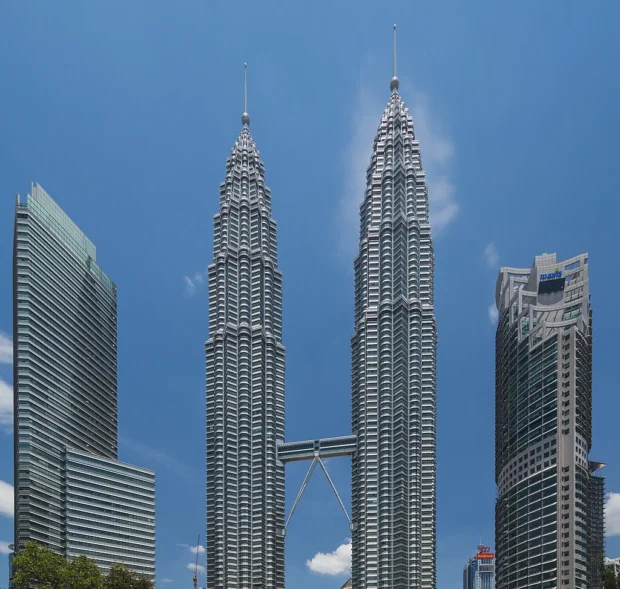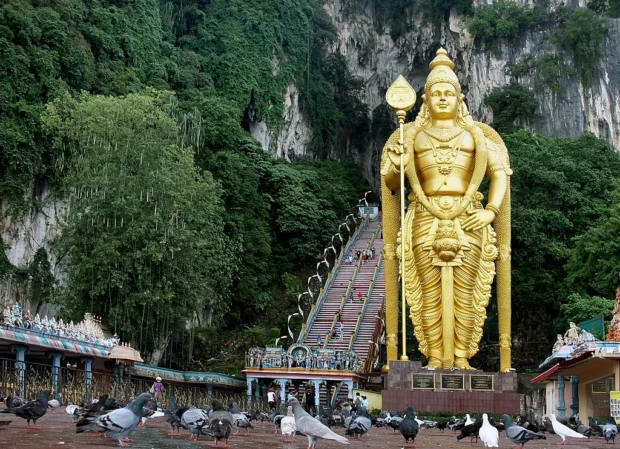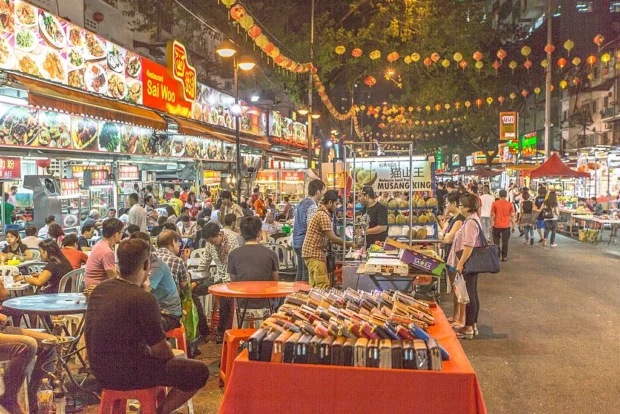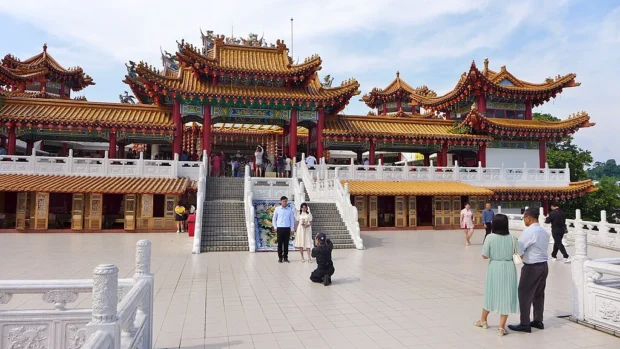Landing in Kuala Lumpur, you step into a city where the past and future play tag among skyscrapers and colonial buildings. Malaysia’s capital mixes warm tropical air with a buzz of motorbikes and the scent of street stalls selling spicy treats. This city is not just a place on the map; it’s a patchwork of stories, tastes, and colors waiting for anyone curious enough to wander its streets. Whether you plan to admire the skyline or savor a fiery dish, Kuala Lumpur offers a lively tapestry of experiences that stretch beyond the usual tourist paths.
Table of Contents

City Highlights and Iconic Buildings to See
The most famous sight is the Petronas Twin Towers, standing tall and gleaming like a pair of silver swords pointing to the sky. You can walk on the sky bridge connecting the two towers-though tickets sell out quickly, so get yours early! The official site of the towers allows booking in advance, making your visit smoother and less stressful. Nearby, KL Tower offers a different view, from a rotating restaurant that makes you feel on top of the world.
For those fascinated by Kuala Lumpur’s symbols, exploring the Petronas Towers in detail reveals even more about the city’s unique architecture and culture.

But beyond these landmarks, Kuala Lumpur invites exploration into quieter corners. The Sultan Abdul Samad Building with its Moorish architecture and copper-domed clock tower sits near Merdeka Square, a perfect place for photos-and also a spot where Malaysia declared independence. I learned that locals affectionately call the square “Dataran Merdeka” and often gather here for festivals and fireworks.

Hidden Corners and Unexpected Delights
Wandering away from the crowds, I found a small park called Bukit Nanas Forest Reserve, right inside the city. It’s one of the last patches of rainforest that survived urban sprawl. Climbing the wooden trails, I could hear the calls of birds and monkeys-imagine, a rainforest in the heart of a megacity! This spot rarely appears on glossy postcards but offers a refreshing break from concrete and traffic.

Then, there’s the charming Kampung Baru neighborhood, a cluster of wooden houses and narrow lanes where traditional Malay life quietly buzzes alongside Kuala Lumpur’s gleaming towers. The contrast here struck me hard: yes, modernization and tradition coexist, sometimes awkwardly, sometimes beautifully.

Where to Find Comfortable Places to Stay
Kuala Lumpur welcomes all kinds of visitors, with neighborhoods that suit different tastes and budgets. The central area near Bukit Bintang is lively and packed with shopping malls and cafes, perfect if you want to be near action. For a calmer vibe, neighborhoods like Bangsar offer leafy streets and cozy guesthouses that feel like a home away from home. I stayed in a small guesthouse there once-it was so inviting that I almost forgot I was in a buzzing capital city.

Public transport is easy to navigate. From the airport, the KLIA Ekspres train zips you straight to the city center in under 30 minutes-fast, clean, and reliable. Once in town, the LRT and Monorail trains connect most districts, making it easy to jump from culture spots to food markets without hassle. Avoid peak hours to dodge the crush; locals kindly tip newcomers on this unwritten rule.

Flavors of Kuala Lumpur: A Food Lover’s Diary
Let me tell you about the food-it’s a feast of colors, spices, and smells that made my taste buds dance. Jalan Alor, a famous food street near Bukit Bintang, is a symphony of clattering woks and sizzling grills. I tasted char kway teow here-flat rice noodles stir-fried with egg, prawns, and Chinese sausage. It’s smoky, slightly sweet, and rich, reminding me of a deep-fried noodle dish from home but bolder in flavor.
For a different vibrant city experience, consider how Johannesburg’s lively markets and rich culture offer a unique contrast to Kuala Lumpur’s urban charm.

Dive into the flavors of nasi lemak from the Kampung Baru market. This dish is Malaysia in a plate: coconut milk-infused rice crowned with crispy anchovies, peanuts, boiled egg, and spicy sambal chili. The first time I tried it, the blend of creamy, hot, and crunchy surprised me enough to ask the vendor for the recipe-although he just smiled and said, “It’s the heart of Malaysia.”

Don’t miss the dim sum in Brickfields, Kuala Lumpur’s Little India and Chinese quarters combined. Here, tiny steamer baskets come filled with dumplings, buns, and rolls, each bite a surprise. I spent an entire afternoon snapping photos of colorful dim sum that looked like little edible jewels, all while chatting with stall owners who shared stories of recipes passed down through generations.

Customs and Culture: Conversation With Locals
Kuala Lumpur’s culture is a beautiful mix of Malay, Chinese, Indian, and indigenous influences. When speaking with locals, I learned a few easy customs that make visits smoother. Greeting with a polite nod or the traditional “salam” handshake shows respect. Always remove your shoes when entering homes or some temples. And here’s a little tip: don’t point with your finger; use your thumb instead-this small gesture is considered polite in Malaysia.
For those drawn to vibrant Asian cities, Hong Kong’s lively markets and unique neighborhoods offer a fascinating contrast to Kuala Lumpur’s blend of tradition and modern life.
The city’s people are warm and often curious about foreign visitors. I found that a simple “terima kasih” (thank you in Malay) melts walls faster than any guidebook advice. Festivals pop up throughout the year, from the colorful Deepavali to the lively Hari Raya Aidilfitri, inviting travelers to join the celebrations and taste special sweets like kuih lapis, a layered cake with a soft jelly-like texture.
Fun Facts and Stories You Won’t Hear in Guides
Did you know the famous Petronas Towers were once the tallest buildings in the world? But the story behind their design is even more fascinating. Architect César Pelli drew on Islamic art patterns, like the eight-pointed star, linking modern engineering with centuries of heritage. The towers are not just steel and glass but a tribute to Malaysia’s cultural roots.
One evening, I chatted with a local artist in the Chinatown area, who told me about the “Hantu Tetek” ghost-a funny spirit legend that locals use to entertain children at night while reminding them to be brave. These small stories, full of humor and local color, reminded me how every city is alive beyond its surface.
And a quirky thing: Kuala Lumpur’s monorail stations sometimes play traditional melodies when arriving or departing, blending technology with tradition in small, unexpected ways.
Final Thoughts on Visiting Kuala Lumpur
Kuala Lumpur is a city that invites curiosity, whether through its soaring towers or steaming bowls of laksa. It’s a place where you can find dazzling skylines buttressed by patches of green, old temples tucked near bustling shops, and the hum of daily life that never quite stops. My time here was a patchwork of tastes, sights, and warm conversations, moments that tasted like rich curry and felt like a welcoming smile.
Perhaps the best way to enjoy Kuala Lumpur is with a slow pace. Walk more, eat more, and chat more. You’ll find that this city reveals its secrets when you take your time and let its stories unfold naturally.

- Kuala Lumpur Malaysia Skyline-03 by CEphoto, Uwe Aranas on Wikimedia Commons – cc by-sa 3.0
- 2016 Kuala Lumpur, Petronas Towers (26) by Marcin Konsek on Wikimedia Commons – cc by-sa 4.0
- Batu Caves. Kuala Lumpur, Malaysia. (17721587095) by Bernard Spragg. NZ from Christchurch, New Zealand on Wikimedia Commons – cc0
- Dataran Merdeka 1 by Haakon S. Krohn on Wikimedia Commons – cc by-sa 3.0
- Bukit Bintang, Kuala Lumpur, Federal Territory of Kuala Lumpur, Malaysia – panoramio (55) by Daibo Taku on Wikimedia Commons – cc by 3.0
- KL Tower, Kuala Lumpur, Malaysia by Salmiah La Suma on Wikimedia Commons – cc by-sa 4.0
- Islamic Arts Museum Malaysia by Chongkian on Wikimedia Commons – cc by-sa 4.0
- Jalan Alor – Kuala Lumpur by IQRemix on Wikimedia Commons – cc by-sa 2.0
- KL – Masjid Negara 0001 by Stefan Fussan on Wikimedia Commons – cc by-sa 3.0
- 2016 Kuala Lumpur, Ulica Hang Lekir (01) by Marcin Konsek on Wikimedia Commons – cc by-sa 4.0
- Thean Hou Temple, 2023 (06) by Bahnfrend on Wikimedia Commons – cc by-sa 4.0
